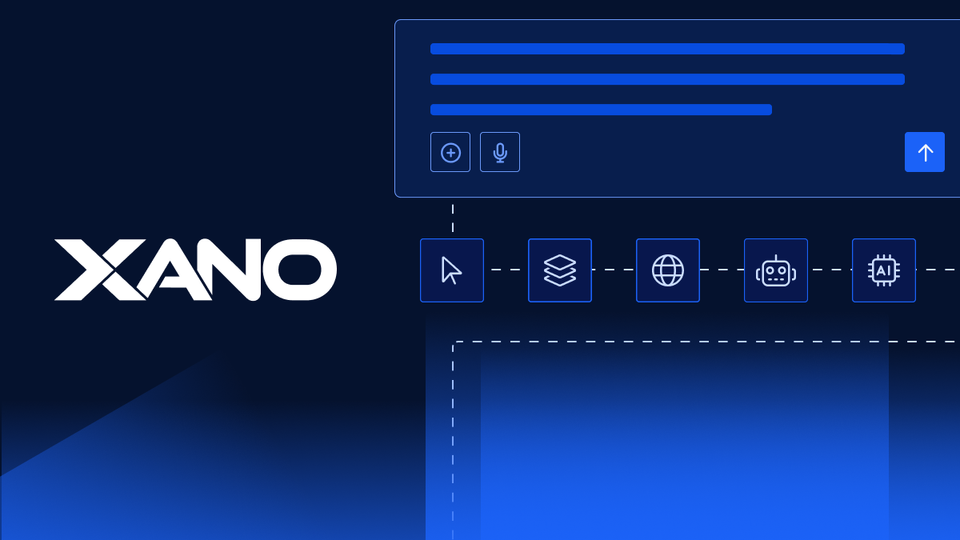The Future of AI and Visual Development: Takeaways from AMA with Xano CEO Prakash Chandran

In a recent AMA, our CEO Prakash Chandran sat down with Xano’s own Daniel Petro to talk about where AI and visual development are headed—and what it all means for developers, builders, and anyone looking to turn ideas into software. It was a fun conversation with great engagement from our community (thank you for the many thoughtful questions!) and a few big-picture ideas worth chewing on.
Here are some of the key takeaways:
1. Visual Development Is Breaking Down Barriers
Prakash opened by talking about how visual development tools are changing the game. You don’t need to be a full-stack dev to build something meaningful anymore. With no-code and low-code platforms like Xano, people at all skill levels are building real, scalable apps—faster than ever.
Daniel Petro, who hosted the AMA, chimed in with his own journey. He shared how using visual tools has accelerated his growth and helped him understand complex systems without needing to dive into thousands of lines of code. It was a reminder that these tools aren’t just about speed—they’re also about learning and empowerment.
2. AI: Are You Building With It or For It?
One of the more interesting distinctions Prakash made was between building with AI and building for AI:
- Building with AI means using co-pilots or assistants to help you build apps faster—generating code, suggesting logic, automating the boring stuff.
- Building for AI is about designing systems for a future where AI agents are interacting with each other. That means embracing new protocols like MCP (Multi-Agent Communication Protocol) and A2A (Agent-to-Agent), and building apps that can speak that language.
This shift is already underway, and it’s going to have a big impact on how we architect modern apps.
3. “If You Don’t Understand It, You Don’t Own It”
Prakash dropped this notable phrase during the AMA: “If you don’t understand it, you don’t own it.”
In other words, if AI generates a bunch of code for you but you have no idea what it’s doing, you’re flying blind. That might be fine at first—but when something breaks (and it will), or when you need to make a change, you’re stuck.
In many cases, it becomes impossible to “prompt your way out of it” and you have to either start over or hire a more experienced dev to help.
That’s why visual development is such a powerful complement to AI. You can still use AI to go fast, but when it’s time to dig in and make adjustments, you’re doing it in an environment you understand. You’ve got a clear view of the logic, a structured visual interface, and way less surface area to stress over. It’s the best of both worlds—speed and control.
4. Prompt-to-App Is Exploding… But Infrastructure Is the Hard Part
There are a lot of shiny new prompt-to-app platforms out there right now—tools like Lovable and Bolt that promise to turn your idea into an app instantly with just a few words. And that’s exciting!
But here’s the thing Prakash pointed out: Code generation is the easy part. The hard part is building the infrastructure that supports real, production-grade software—something that’s fast, secure, scalable, and reliable.
That’s where Xano really stands out. We’ve been focused on infrastructure from the very beginning. So when you build with Xano, you’re not just generating an app—you’re building real software that can actually stand up in the real world. That’s not something you can fake with a clever prompt.
Good news for those of us who are enjoying these tools: Expect Xano to begin integrating more seamlessly with Bolt, Lovable, and other prompt-to-app tools in the near future, especially as we look to introduce our own scripting language, XanoScript, that will make it easier for developers to and tools to generate Xano infrastructure through code.
5. The Real Race Is Visual UX, Not Code Gen
There’s another trend happening right now: Prompt-to-app platforms are starting to converge with visual development. People want to generate an app quickly with AI, but they also want to understand and control what they just created—and the best way to do that is with a clean, intuitive visual interface.
This is where Xano is especially well-positioned. Visual development is our bread and butter. And while everyone’s racing to build smarter code generation, we’re focused on the hard stuff: user experience, developer experience, and education. That’s where the real value is. Code gen is table stakes—what you do after the code is generated is what matters.
Final Thoughts
If there’s one big takeaway from this AMA, it’s this: AI is here, and it’s changing the game—but it’s up to us to stay in control of the process. Visual development gives you the speed and power of AI, without sacrificing clarity or ownership. And as we start building for a future filled with autonomous agents and AI-to-AI interactions, that kind of control is going to matter more than ever.
The good news? Tools like Xano are already set up to help you build for that future. Whether you’re just starting out or you’ve been writing code for years, visual development + AI + strong infrastructure is a powerful combo.
🎥 Missed the live AMA? You can catch the full conversation here: Watch Now